It has been another tough year for the business aircraft industry and the gloom looks set to continue for all but the fortunate few at the top end of the market. Here, the demand for long-range and large-cabin aircraft is being fuelled by very wealthy individuals unaffected, it seems, by the economic hurricane that has ripped through the western world.
Daniel Hall, aerospace consultant with Flightglobal Ascend, says the outlook for the business market is uncertain. "Although many sales happen towards the end of the year, transaction activity to date is some 30% down on 2010," he says. "Real risks going forward now lie within the state of the global macro economy - the outlook heading towards 2012 remains unclear in this respect, although arguably as the business jet sector never fully recovered, [a] further downside would be narrower in another recession."
Hall's views are echoed throughout the industry as the US and European economies flatline. "Business aircraft recovery, like the economic recovery, has entered an uncertain phase in the mature markets," says Teal Group aviation analyst Richard Aboulafia. "While a double-dip recession looks unlikely, the financial crisis overhang is suppressing demand for every form of capital investment, and business jets are no exception."
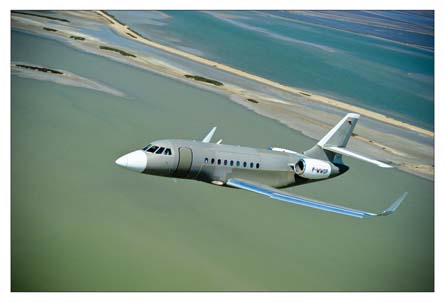 |
|---|
| © Billypix Dassault has returned to the niche super midsize sector with the launch of the Falcon 2000S |
Flight International's 2011 business aircraft census, compiled using Flightglobal's ACAS business aviation database, reflects the industry's feeble performance in the 12 months from 31 August 2010. It reveals the world's active turbine corporate aircraft fleet climbed by just over 1% to 28,920 jets and turboprops, compared with 28,614 aircraft in 2010. Although the business jet fleet has grown by a modest 4%, the turboprop inventory has remained almost at a standstill throughout the census period, inching forward by less than 0.5% to 10,811 units.
LIGHT-JET COLLAPSE
The stagnation of the turboprop market is a barometer for the poor health of the lower end of the business aircraft spectrum. Sales of light business jets, for example, have plummeted to their lowest levels for years as demand from traditional buyers - small companies, owner-flyers - has dried up. Simultaneously, the used inventories for these types have remained stubbornly high at about 14% of the total fleet, forcing price tags to record lows, says Oliver Stone, director of international aircraft broker Colibri Aircraft. "It is certainly a buyer's market right now," he adds.
The paucity of demand for small aircraft persuaded Cessna and Hawker Beechcraft to halt production in the past 12 months of the poor-selling 400XP and CJ1 business jets. Nonetheless, with an inventory of 5,955 Citations recorded in this year's census, Cessna dominates the global business jet fleet.
During the past 12 months, the largest gains were made by the Mustang entry-level jet, with the fleet rising from 315 aircraft to 366. The CJ4 made its debut this year with 31 aircraft, and Cessna will hope this new generation light business jet will help to revive its fortunes in this fragile sector. It still has one eye on the top end of the market and has not ruled out relaunching its large cabin Columbus business jet. In the meantime, the airframer is believed to be working on a number of product upgrades to its super-light and midsize offerings - the XLS+ and Sovereign - to stimulate demand and fend off competition from the Embraer's eagerly anticipated Legacy 400 and 500. Embraer is maintaining schedules for these mid-range product offerings in the hope the market will recover. The larger Legacy 500 is earmarked for service entry in the second half of 2012, a year ahead of the mid-light Legacy 450.
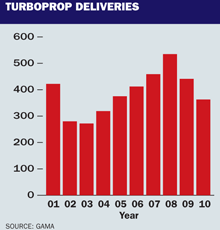 | 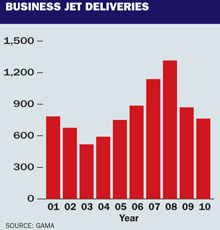 |
|---|
Despite being a relative newcomer to the business jet arena, Embraer has managed to boost its market share year on year with its five products. Once again, the Brazilian airframer has made the largest fleet gains of any manufacturer - a 30% increase in its global inventory to 475. The Phenom 100 inventory climbed from 153 to 208, while the tally of the larger Phenom 300 light jet rose from 12 to 46 aircraft. The large-cabin Legacy 650 makes its census debut with nine of the types listed so far, while only two of its Legacy 600 stablemates have been added since the last report. The top of the range Lineage 1000 has fared slightly better, with six new aircraft added to the now nine-strong fleet.
Product upgrades are Hawker Beechcraft's lifeblood, with the new, more powerful, longer-range King Air 250 turboprop scheduled for service entry this year and the Hawker 200 - formerly the Premier II business jet - expected to follow in 2012. The winglet-equipped aircraft will replace the Premier IA in service. The airframer has seen its business fleet climb to 2,540 aircraft this year, including 149 950XPs, 44 750s and 51 Hawker 4000s. And its 46-year-old King Air retains its unrivalled dominance of the turboprop market, with a fleet of about 5,500. This type represents more than half the world's twin-turboprop fleet, which includes 630 350 series, 1,100 B200-series and 134 C90 series aircraft.
LARGE-CABIN BOOM
Bombardier's diverse product line has helped to lessen the impact of the economic crisis on its lower-end business jets. The Canadian airframer grew its inventory during the census period from 3,676 to 3,760 business jets. Not surprisingly, Bombardier's light/super-light jet offerings have taken a beating this year. The Learjet 40XR and 45XR tallies climbed by three and 15 respectively, while its midsize Learjet 60XR inventory rose by only nine. The airframer hopes its new, all-composite Learjet 85 will dominate the midsize cabin arena when it enters service in 2013.
In the super midsize arena, Bombardier's Challenger 300 fleet has risen by 30 to 310 jets since the last census. The Challenger 650 made an impressive gain of 31 aircraft to 153, in contrast with its larger stablemate the 850 which nudged ahead by only three to 52. At the top of its range, Global 5000 fleet numbers climbed by 10 to 98 and the 6000 - formerly XRS - by 16 aircraft to 142 of the long-range types. The first of Global 5000s and 6000 Visions - equipped with the Rockwell Proline Fusion flightdeck - are earmarked for delivery in January 2012.
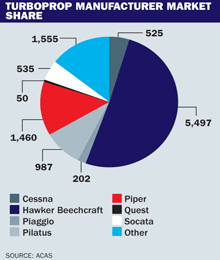 | 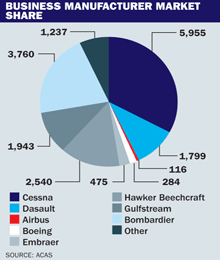 |
|---|
A year ago, Bombardier cemented its position as a leading player in the long-range, large-cabin market with the introduction of its Global 7000 and 8000 aircraft at the top of the traditional business jet spectrum. The aircraft - scheduled to enter service in 2016 and 2017 respectively - have already chalked up substantial sales, including a 20-strong order from fractional ownership giant NetJets.
The aircraft's closest competitor - the Gulfstream G650 - remains on course to enter service in early 2012, despite the fatal accident involving its second test aircraft, in April. The orderbook for the ultra long-range business jet remains strong - a reflection perhaps of the rude health of this market sector. The Savannah, Georgia-based airframer has seen its in-service fleet jump by 2% to 1,943 business jets, including a 20% increase in the long-range G550 inventory to 295 aircraft, a 15% increase in the large-cabin G450 fleet to 209, a 65% increase in its G150 tally to 88 and a 7% increase in the G200 tally, to 229. The super midsize aircraft is to be replaced this year by the more powerful G280.
Earlier this year, the lure of the super-midsize niche persuaded Dassault to return to this sector with the launch of the Falcon 2000S. Its previous super midsize offering - the Falcon 50EX - was discontinued in 2007. The 10-passenger 2000S will sit at the bottom of Dassault's product line and be pitched against the Challenger 300, Hawker 4000 and Gulfstream G280 when it enters service later this year. During the census period, the French airframer's fleet has risen by 48 to 1,799 Falcons, including 114 7X jets - 30 more than last year. It has 80 2000LX jets - almost double last year's tally of 44 - and seven winglet-equipped, large cabin 900LXs, which make their census debut this year. The resurgence at the top of the business jet market has helped Airbus and Boeing to expand their fleets of VIP-configured airliners.
Cancellations and deferrals across the BBJ family have slowed during the past 12 months. This year's census reveals fleet gains for the BBJ, BBJ2, BBJ3 and cargo door-equipped BBJC of six aircraft. The BBJ widebody 777 tally has grown by three to five VIP-configured types, while delivery of the first VIP747-8 - set to rival Airbus's ACJ340 - is earmarked for delivery soon. Meanwhile, Airbus has grown its installed base by nine to 116 corporate airliners. The single-aisle ACJ318Elite and ACJ319 have risen by one and six respectively, while the twin-aisle ACJA330 and ACJA340 have each risen by one.
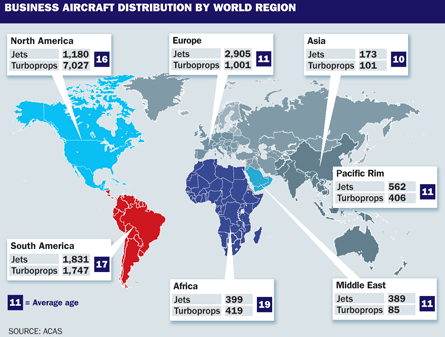 |
|---|
The international market has been a lifeline for major airframers and the financial meltdown in the US and several European countries is manifested in the latest census numbers. In North America - the largest installed base of business aircraft - the tally has climb little more than 1.5% to 18,877 business jets and turboprops. Meanwhile Europe has seen inventory grow by a modest 1.9% to 3,906, with the bulk of this growth in Russia and Germany, with gains of 16 and 22 business jets respectively.
In the booming Latin America region the installed base climbed in the census period by 267 jets and turboprops to 3,578 aircraft. This 8% climb is mostly attributable to the booming economies of Brazil and Mexico, where demand for these flexible forms of transport is booming. In Brazil - home to the largest installed base of business aircraft in the region - the fleet rose by 91 jets and turboprops. Meanwhile, in Mexico - home the continent's largest business jet fleet - the tally reached 640 jets and 285 turboprops.
The Pacific Rim has also made strides during the past 12 months. ACAS lists the fleet rise at more than 6% to 562 jets and 406 turboprops. The growing dominance of the Chinese market is reflected this year, with an impressive fleet gain of 20% to 112 jets and 12 turboprops. The world's airframers expect the market to grow at an even greater pace as the country's economy continues to boom, regulations become more relaxed and the military loosens its grip on the nation's airspace.
Source: Flight International
















